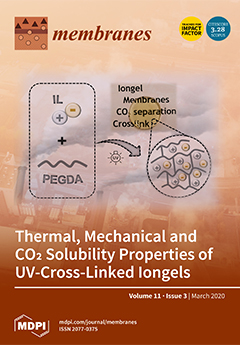This study investigates the effect of different additives, such as coagulants/flocculants, adsorption agents (powdered activated carbon, PAC), and bio-film carriers, on the fouling propensity of a lab-scale membrane bio-reactor (MBR) treating synthetic municipal wastewater. The coagulation agents FO 4350 SSH, Adifloc KD 451,
[...] Read more.
This study investigates the effect of different additives, such as coagulants/flocculants, adsorption agents (powdered activated carbon, PAC), and bio-film carriers, on the fouling propensity of a lab-scale membrane bio-reactor (MBR) treating synthetic municipal wastewater. The coagulation agents FO 4350 SSH, Adifloc KD 451, and PAC1 A9-M at concentrations of 10 mg/L, 10 mg/L, and 100 mg Al/L, respectively, and PAC at a concentration of 3.6 ± 0.1 g/L, exhibited the best results during their batch-mode addition to biomass samples. The optimal additives FO 4350 SSH and Adifloc KD 451 were continuously added to the bioreactor at continuous-flow addition experiments and resulted in increased membrane lifetime by 16% and 13%, respectively, suggesting that the decrease of SMP
c concentration and the increase of sludge filterability is the dominant fouling reduction mechanism. On the contrary, fouling reduction was low when PAC1 A9-M and PAC were continuously added, as the membrane lifetime was increased by approximately 6%. Interestingly, the addition of bio-film carriers (at filling ratios of 40%, 50%, and 60%) did not affect SMP
c concentration, sludge filterability, and trans-membrane pressure (TMP). Finally, the effluent quality was satisfactory in terms of organics and ammonia removal, as chemical oxygen demand (COD), biochemical oxygen demand (BOD)
5, and NH
-N concentrations were consistently below the permissible discharge limits and rarely exceeded 30, 15, and 0.9 mg/L, respectively.
Full article






